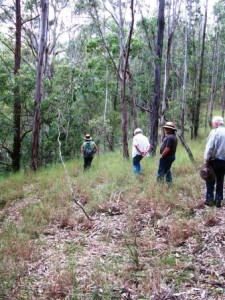Field Day October 2015
Our last field day was held at the property of Jane Richens and Brian Doherty, Tabbil Forest situated on the Bingleburra road. The property is over 600, and has a unique feature, 200 acres of dry temperate rainforest which amazingly has never been disturbed (logged). This is the largest undisturbed rainforest on private land in the region. Jane and Brian have owned the property for over 15 years, and did not realise the extent of the rainforest until after they had made the purchase. A PVP contract is in place for improving the biodiversity.
The topic of the day was Farming Endemic Diversity – basically looking at the rainforest and what management practices have been used to control weeds, in particular lantana. Lantana at the edge of the rainforest was allowed to remain to reduce the incursion of other weeds – lantana does not penetrate into well shaded areas. The pleasure of the day was increased by the weather – mild temperature, overcast (less UV), and with a small amount of rain (befitting a rainforest) during the lunch break when we were under cover. The field day was attended by over 20 members.
Jane and Brian have a grant to support their weed management efforts, using both the splatter gun (10% glyphosate) and manual removal for lantana. They have found that, while the splatter gun is very effective for dense infestations of lantana, for more sparse (and less leafy) bushes in dry sclerophyll forest conditions the splatter gun is less effective (requiring double concentration of glyphosate for a reasonable kill rate) and the manual removal is preferred.
In addition to seeing a section of rainforest, we were shown areas along the main creek through the property, which had been a raging torrent during the rain event which devastated Dungog. On the banks of the creek there were extensive areas of lantana and other weeds which were being treated chemically.
After lunch a large section of dry sclerophyll forest was inspected, in which the sparse clumps of lantana had been manually removed. Plants identified by Fred and Annabel were duly added to Jane’s species list.
Overall, it is fortunate that this property with its extensive rainforest is in good hands, and it was clear that the grant has enabled them to make good progress with weeds using their own labour.
During the day, Jane showed the group a few references that she uses to identify the species in the rainforest – an interactive key and a Dictionary of Botanical Names (the Blue Book).
‘Rainforest plants of Australia: Interactive identification key and information system Rockhampton to Victoria’; this has been created collaboratively between the people that put out the well-known ‘red’ book – Gwen Harden, Bill McDonald & John Williams – and the photographic books of Hugh and Nan Nicholson. It is available from Gwen Harden Publishing http://rainforests.net.au at a price of $80 (single user)
‘Dictionary of Botanical Names’ Australian plant names: meaning, derivation, & application’ – compiled & illustrated by Don Perrin, 22 Church St, Kippa Ring 4021, phone: 07 3284 7420. Don is not too keen on the digital age, but will respond promptly to a letter with an enclosed cheque for $15 (includes postage)
